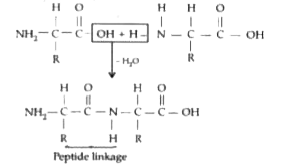What is meant by :
(i) Peptide linkage .
(ii) Biocatalysts ?Solution in Kannada
(i) Peptide linkage : Proteins are complex nitrogenous polymeric substance present in all from of living matter . These are obtained by the condensation polymerisation of α - amino acid through the formation of peptide bonds. The linkage which combine two amino acids is called peptide linkage .

(iii) Biocatalyst : Enzyme are complex nitrogenous substance (protein) having molecular weight of 10,000 or even more . Enzyme increase the rate of biochemical reactions by providing alternative path of lower activation energy.
Therefore , enzyme are termed as biochemical catalyst and phenomenon is known as biochemical catalysis.
Topper's Solved these Questions
- BOOK - OSWAAL PUBLICATIONCHAPTER - BIOMOLECULESEXERCISE - TOPIC -II (LONG ANSWER TYPE QUESTIONS)2videos
BIOMOLECULES
- BOOK - OSWAAL PUBLICATIONCHAPTER - BIOMOLECULESEXERCISE - TOPIC -II (VERY SHORT ANSWER TYPE QUESTIONS)5videos
BIOMOLECULES
- BOOK - OSWAAL PUBLICATIONCHAPTER - ALDEHYDES, KETONES AND CARBOXYLIC ACIDSEXERCISE - TOPIC -3 METHODS OF PREPARATION OF CARBOXYLIC ACID, PROPERTIES AND USES (LONG ANSWER TYPE QUESTIONS II)7videos
ALDEHYDES, KETONES AND CARBOXYLIC ACIDS
- BOOK - OSWAAL PUBLICATIONCHAPTER - CHEMICAL KINETICSEXERCISE - Topic - 2 (ORDER OF A REACTION , INTEGRATED RATE EQUATIONS AND HALF LIFE OF A REACTION )Long Answer Type Questions - II)4videos
CHEMICAL KINETICS
Similar Questions
What is α - amino acid ? Give its general structure.
02:21View SolutionGive one reaction to indicate the presence of a carbonyl group in gluocse.
02:23View SolutionA ketone A(C4H8O) which undergoes a haloform reaction gives compound B on reduction. B on heating with sulphuric acid gives a compound C whch forms mono-ozonide D. D on hydrolysis in presence of zinc dust gives only acetaldehyde E. Identify A,B,C,D and E. Write the reaction involved.
03:12View SolutionThe half-life period of a certain reaction is directly proportional to initial concentration of the reactant. Predict the order of the reaction and white the expression to calculate the half-life period of the reaction.
View SolutionExplain what is meant by the following : (i) peptide linkage (ii) pyranose structure of glucose.
02:58View SolutionWhat is meant by
(i) peptide linkage
(ii) biocatalysts01:43View SolutionDescribe the following
(i) Glycosidic linkage
(ii) Peptide linkage.02:04View SolutionExplain what is meant by
(i) a peptide linkage
(ii) a glycosidic linkage05:14View SolutionExplain what is meant by (i) a peptide linkage, (ii) a glycosidic linkage.
02:22View SolutionWhat is meant by (i) peptide linkage (ii) biocatalysts ?
View SolutionWhat is meant by
(i) petide linkage (ii) biocatalysts ?05:04View SolutionWhat is meant by Peptide linkage
07:12View SolutionExplain what is meant by : (i) Biocatalyst
View SolutionExplain what is meant by (i) a peptide linkage (ii) a glycoside linkage .
View Solution(a) What is meant by (i) a peptide linkage (ii) a glycosidic linkage? (b) Name the bases present in RNA. Which one of these is not present in DNA?
View Solution(a) What is meant by (i) peptide linkage (ii) biocatalysts? (b) Write any two reactions of glucose which cannot be explained by the open chain structure of glucose molecule.
View Solution

